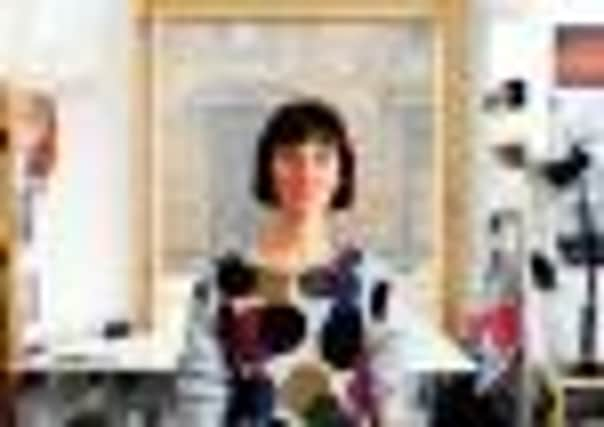Interview: Kate Davis, Glasgow artist


MOST stately homes probably have ghosts. But Mount Stuart on Bute should be the exception. Despite it’s ornate neo-gothic style, it seems so resolutely modern. Built in 1879, it is believed to be the first home in the world to have an indoor heated swimming pool and, as its website states, “the first in Scotland to have electric lighting, central heating, a telephone system and a Victorian passenger lift”.
Paradoxically, this curious time warp, the mixture of ancient and modern, from the old master paintings of the Bute Collection (some of which are on loan to the National Gallery of Scotland) to those innovative electric features and its annual contemporary art programme, makes it particularly ghostly, particularly rich. It’s a place where past and present seep into one another, where history is ever reinvented.
Advertisement
Hide AdAdvertisement
Hide AdI’ll never forget the time I visited and glimpsed the ancient grounds dotted with helicopters for a family funeral. And each time I return I seek out the magnificent tall tree in the gardens whose bark artist Anya Gallacio once carefully coated in silver leaf. Nothing in the grand house and gardens is immune from change.
It’s in this spirit that Glasgow artist Kate Davis, someone whose art reanimates the past with the urgency of present needs, has approached her invitation to work at Mount Stuart as part of this summer’s group show Sanctuary/Comraich with artists including Turner Prize nominee Lucy Skaer. “It’s an amazing resource,” she says when we meet at Glasgow’s Mitchell Library. “Especially for an artist, because of its history of commissioning wonderful works, including its stained glass and its wood panelling. It’s an imaginative, exciting space.”
But while Davis, who has held exhibitions in formal art museums such as Tate Britain and the Kunsthalle Basel, was dazzled by its rich interiors and immersed herself in the archive, a little known episode in the house’s history really captured her imagination.
During the First World War, the then Lady Augusta Bute offered the house to the army and then the admiralty for use as a hospital for servicemen.
“At Mount Stuart you are so immersed in this all-encompassing experience of the house, it’s a sensory experience, you are overloaded,” Davis says. “There is so much care and attention to detail, to have those spaces upturned and completely removed from grandeur to become a space for a completely different function…”
Davis found herself intrigued that a space so given to ornate display could have been so thoroughly transformed. The 34-year-old artist, who studied printmaking at Glasgow School of Art, shows me copies of photographs that document the changes.
During the period 1915 to 1919, more than 2,000 wounded servicemen were treated in a makeshift operating theatre in the conservatory. The Purple Library was an X-ray room. Walls were whitewashed, pillars and bookcases swathed in white sheets. The grand central hall with its painted horoscope ceiling became a vast ward.
Advertisement
Hide AdAdvertisement
Hide Ad“There’s a lovely story that the former archivist Andrew Maclean told me. Once when he was giving a tour around the house one of the visitors suddenly realised that her father must have been a patient there. He had always talked about lying in bed and looking up at this heavenly space, and they always thought it was the medication talking.”
I regret ordering a large and messy latte within minutes of meeting Davis, an artist who in person is as precise and careful as her art. While we talk she brings out a pristine example of a new print she has made, and sketchbooks that show her research processes. She will splice her historical finds with a long-standing interest in the American pop artist Robert Indiana’s graphic artwork Love.
Indiana’s work took many forms, from postage stamps to sculpture. It has become so ubiquitous that it has been honoured and parodied in everything from a Google search page to Converse trainers. But Davis’s art is not interested in history or art history for its own sake, but for the possibilities it offers to rewrite the present, most often from a feminist perspective. Her project is titled What Is The Work Of Love Today?
At Bute, a formal and traditional home long associated with wealth and power, her work will bring in a hidden history of healing and caring, domestic and professional labour. There is, she says, “something about these images of care and labour within Mount Stuart, the gap between the way we experience the house now and what these images suggest”.
It’s a highly unusual set of historical images that Davis will hang in the house’s drawing room alongside her prints and sculpture. She uncovered a set of photographs that have been subtly altered by hand, showing Christmas celebrations and other shared events at the hospital.
“They all have these strange additions which we imagine are maybe drawings added by a child at some point, or a member of the family,” she says. “It was the time of colour tinting, and some of the images are beginning to fade. There are flourishes, things painted out.”
When Davis first saw these pictures, they made both house and hospital seem “as though they had always been an act of the imagination”. It was ever thus with the modern yet mysterious ghosts of Mount Stuart.
• Sanctuary/Comraich is at Mount Stuart, Bute, from 24 June until 31 October. www.mountstuart.com/whats-on/visual-arts